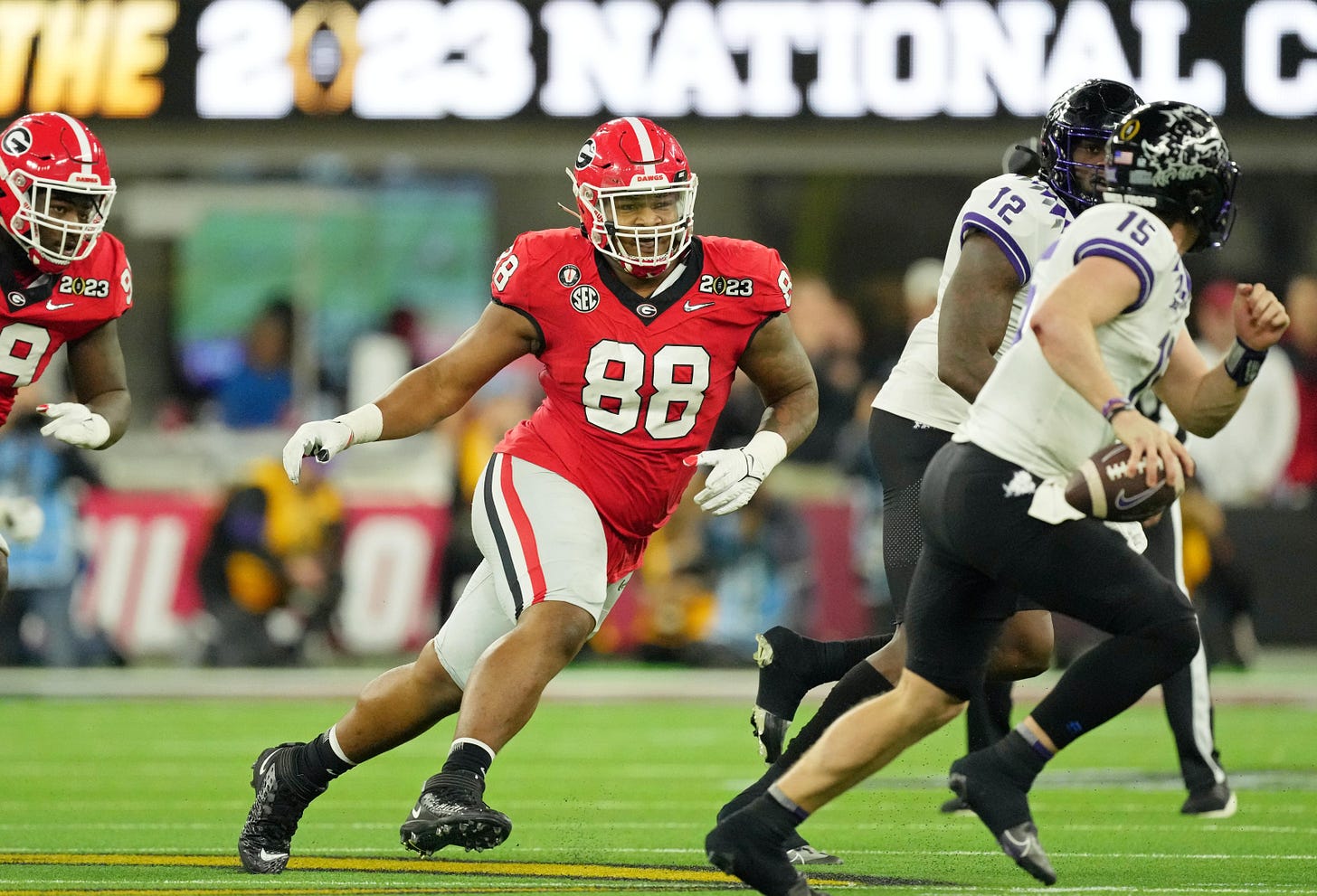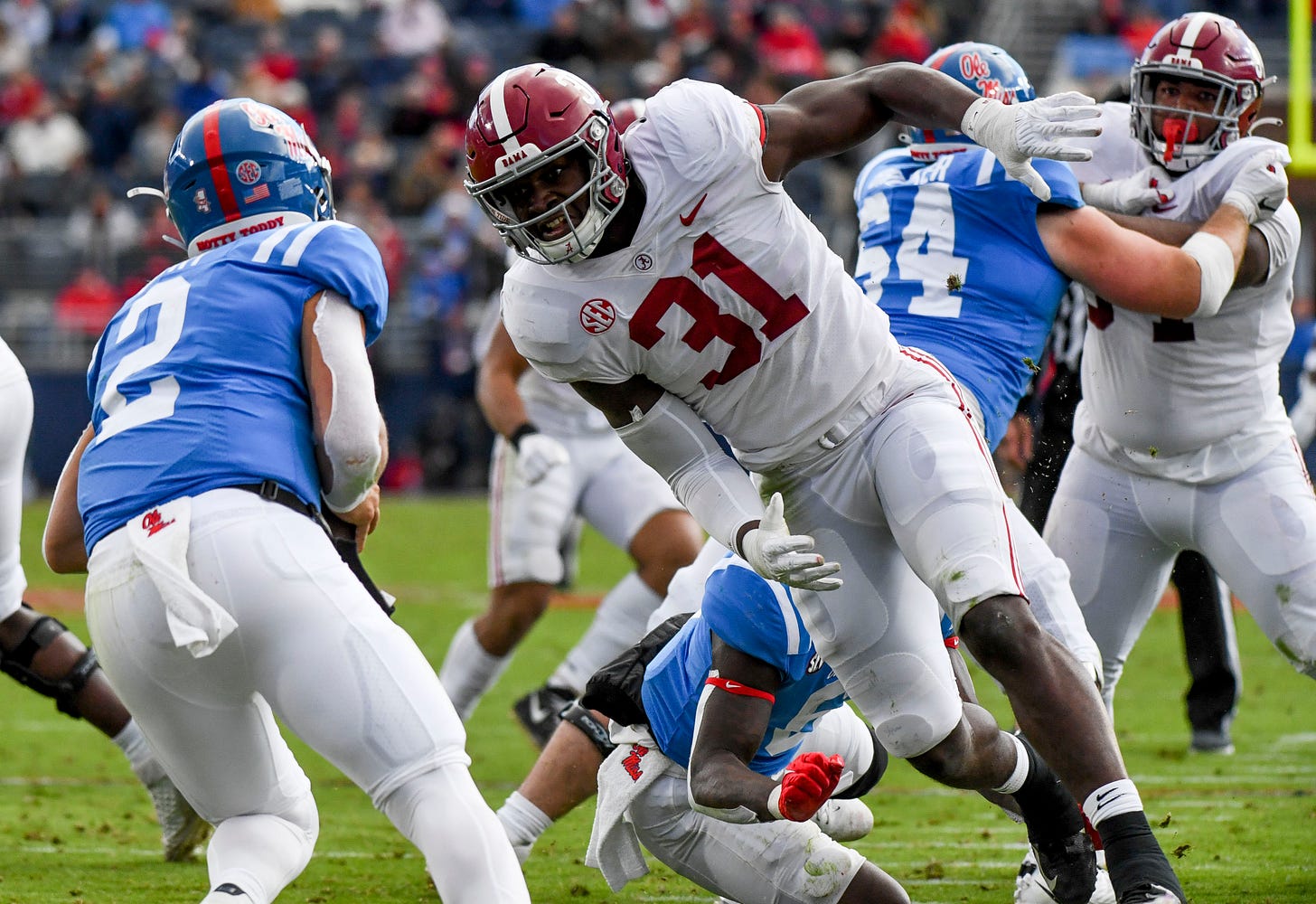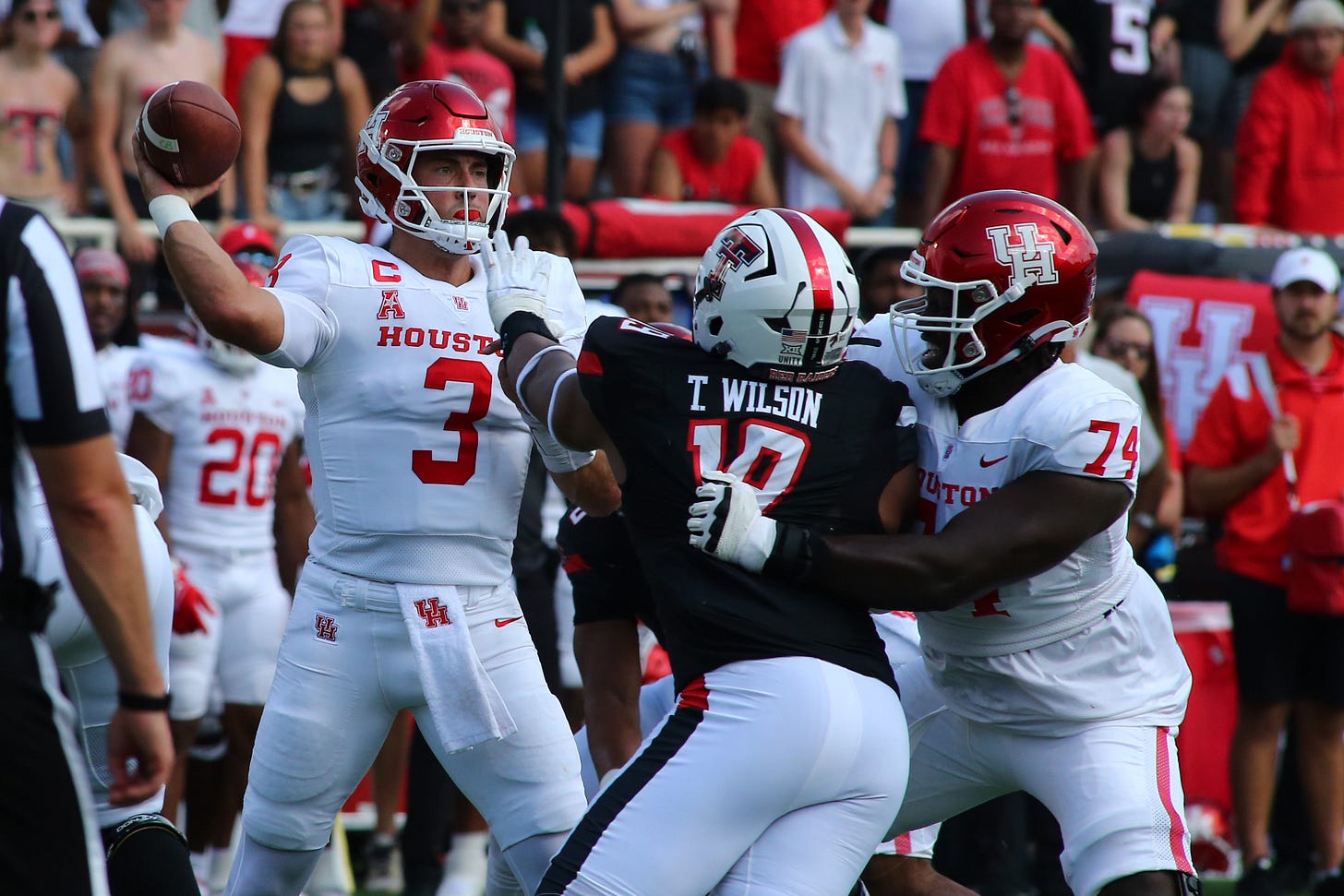#5 Draft Pick Helps Seahawks Be More "Dynamic"
Pete Carroll said the Seahawks need to be "more dynamic" up front; John Schneider echoed that at the combine: at #5 in the 2023 NFL Draft, Seattle will have this type of defender available right away
Right as Seattle’s 2022 season ended, it was clear where the Seahawks needed to upgrade: defensive line and outside linebacker. Better down-at-the-line-of-scrimmage guys are required.
Tellingly, an audibly frustrated Pete Carroll—when reflecting on the season-ending, wildcard round defeat to the San Francisco 49ers—opened by highlighting this issue.
“Really we’re gonna have to become more dynamic up front,” Carroll told Seattle Sports on January 16th. “We have to, you know? We’ve kinda been in the same mode. We’ve gotta get more production out of the guys, they’ve gotta be more of a factor.”
This “dynamic” nature up front applies versus run and pass, on any down, to all facets of the defense.
“We need to rush the passer better. We gotta be more of a factor when they’re doubling us, we gotta split the double teams,” Carroll added. “We gotta, all those things. And our guys busted their tails to do it. We need to make sure that we’re more of a factor. It’s not a factor enough for us to be really effective like we want to be. So we have to find ways to do that. So that will come.”
Part of this is coaching better, via scheme and technique deals. But what really stood out from Carroll was the head coach assessing that Seattle lacked the required “dynamic” talent in their front.
“The problem is, to really be effective, it needs to be up front,” Carroll described of Seattle’s roster, having praised Jordyn Brooks and Quandre Diggs as standout players. “You need to have those guys that can really do stuff. That cause the problem run and pass every snap. You gotta run the other way, you gotta look out, you gotta cut them off. Those are the factors. It’s like the factor that Aaron Donald brings. That factor overwhelms the gameplan and It becomes a distraction to the rest of it if you can’t handle those guys. That’s where you see the teams that really have the big time potential, defensively.”
For Carroll, being “dynamic” is key to quality defense in today’s NFL. Fresh off defeat, the coach was understandably envious of the 49ers dynamism: “They’ve got a couple of guys, or at least one guy, that you really have to contend with.”
Seattle’s postseason loss was a team playing right on the edge of a gameplan, constantly trying to work around San Francisco’s dynamic front players.
“I would tell you that if you watched the game, it was evident,” John Schneider described in his combine press conference.
On top of improved defensive coaching, Seattle must upgrade.
“We need them to make that position really competitive if we can,” Carroll outlined January 16th. “And we’ll see what we can do.”
The head coach also repeated this goal in his end of season presser: “We need to make it more competitive as well, we need to continue to upgrade.”
“I think we’ve got to get a lot better, yeah,” agreed Schneider in Indianapolis. “We need to be better up front. I think that’s, you know, pretty evident. We were on the field a lot. You know, we didn’t defend the run real well. We had some games where we did a really nice job. And, you know, we had several games where it didn’t go so well. We know what the issues are. And we’re ready to tackle them and fix them.”
Seattle, in foreign lofty territory for team and general manager, picks 5 overall. The way the 2023 draft class is constructed, the Seahawks should have a shot at a dynamic front seven player with their first selection. Say Jalen Carter, Will Anderson Jr., or the wildcard.
Check out our Seattle Overload discussion on these three players, download on your podcast app here.
Jalen Carter/Georgia/Defensive Line
Jalen Carter is the best football player in the draft. It looked like the Seahawks would need a miracle to have a shot at picking Carter. Instead, day one of the combine saw Seattle handed something more tragic.


Until the arrest warrant was issued, the January 15th crash had been reported as a one vehicle incident with Carter not mentioned.
Morally, there’s a lot to understand and unpack. What was Carter’s exact role? Was this a one-time, dumb college kid thing? (According to citations obtained by the Athens Banner-Herald in an open records request Wednesday, Carter was previously stopped by police for speeding on September 22nd, driving a Jeep Cherokee 89mph in a 45mph zone at 7:29pm, 2656 Atlanta Highway)

Returning to the on-field football, Carter cleared the size thresholds at Indianapolis, measuring in at 6-foot-3 tall, weighing 314 pounds with 33 and ½-inch long arms. He is a hyper intelligent player with polished technique from a variety of alignments and in a variety of situations. Carter then has the explosive traits on top of this refinement. He’s a bull-in-a-china-shop. He wrecks plays. He is able to be that “dynamic” player on every down in a lot of different spots, even the less typical ones.
For Seattle, Carter would be able to play in base defense anywhere from the 5-technique spot in an under front to the head-up nose tackle position. 5t, 4i, 3, 2i, 1, 0. All of it. He can power step in a shade, one-gapping, but some of his best plays against the run for Georgia came out of 4i or 2i techniques, mirror-stepping with expert block recognition and pad-back awareness. Two-gapping.

Come nickel 2-4-5, the “over g” front the Seahawks used the most last year, Carter is the dream type for Seattle, with elite play heavy to a guard via similar Georgia looks.
Carter has the technique and athletic tools to be able to win outside, inside, or through a guard. My Seattle Overload co-host Griffin Sturgeon described Carter as a “three-way go” type of player.
His low sack production is initially concerning: Carter had just 6 sacks over his college career, 3 in 2022 and 3 in 2021. He also had 18.5 tackles for loss.
Part of this can be explained by a lot of quick wins from Carter, who when in a one-on-one situation is able to pop out a lethal quick swim after wrong shouldering guards to bash and close the space to create room outside. This, rather than getting to the quarterback, often flushed them from the pocket or forced the quick throwaway.

Along with some pesky variance, Georgia’s scheme didn’t aid these numbers: in the NFL, Carter will get more of a chance to get after it in manufactured one-on-one situations, with two edge rushers setting the perimeter of the pocket, leaving no escape.
Most important, Carter is a reduced sample size case. The Bulldogs utilized a deep rotation and personnel packages that saw Carter—like all of his teammates—play less snaps than typical. Carter took 396 snaps in 2021, 40% of the total snaps, and 392 snaps in 2022—after missing three games through injury. Once you start to scale these numbers up, they look better.
There have been motor concerns with Carter; these come across more like incorrect interpretations of earlier reports on his make-up. The consternation doesn’t exist on tape. The college football semifinal seems to be where this first gathered traction. Maybe Carter was sick? Here’s the final:

NFL defenses won’t ask Carter to loop as much. And he won’t have to run towards wide hashmarks.
We need Carter’s full legal process to play out. Meanwhile, all 32 teams will be doing as much digging as possible into the Georgia defensive lineman. This is a constantly updated process, from when they started work on this class way back in the fall of 2022 to now.
It’s noteworthy that the media was already questioning Carter’s intangibles before the shocking arrest warrant news broke. ESPN’s Todd McShay raised “character concerns” around Carter on December 29th—before the January 15th incident—while NFL Network’s Lance Zierlein wrote “maturity will need to be vetted” in his draft report.
So, Carter may well fall from the #1 overall selection, or first non-quarterback pick, to Seattle at #5. However, the Seahawks choosing to spend this selection on the 21-year-old, turning 22 in April, is doubtful. Carroll and Schneider, particularly during this new iteration of the team, have publicly, and repeatedly, emphasized the importance of character in prospects. With where we are now, the Seahawks are likelier to let Carter be a challenge for a different team. And he would be unlikely to fall much further:

Will Anderson Jr./Alabama/Outside Linebacker
Will Anderson Jr. seemingly checks all of the character boxes. He can also play football.
Anderson’s standout trait is elite, rare, generational play strength. In 2022, Alabama regularly aligned him as a 4i, inside the tackle, in odd fronts. And Anderson, despite being listed at only 243 pounds, was able to dominate tackles, rocking them back with brilliant technique, striking under their pads with strain and violence, getting his outside arm involved too in order to jackknife blockers.
Anderson pre- and post-snap is highly aware of offensive schemes, anticipating and reacting quickly. His effort is excellent. Seattle would not need a repeat of 2022, where they signed a 35-year-old Bruce Irvin off the street to help set edges following Darrell Taylor’s disappointing performance in this area. Instead, a Seahawk Anderson could be trusted to be an excellent run defender in both 3-4 base looks on the edge but also outside in the 2-4-5 front.
His production, at the SEC level, was outstanding. Anderson finished his three-year career with 34.5 sacks, including 17.5 in 2021 and 10 in 2022. He had 58.5 tackles for loss, 31 in 2021 and 17 in 2022. This is a strong indicator of future success.
Since 2005, Anderson leads the SEC in career sacks. Other noteworthy high sack totals from the conference over three-year careers are Derek Barnett (32), Myles Garrett (31), Jadeveon Clowney (24), Sam Williams (22.5), Derrick Harvey (20.5), Justin Houston (20), Arden Key (20), and Carlos Dunlap (19.5)
Since 2005, Anderson leads the SEC in career tackles for loss. Since 2005, Anderson leads the SEC in career TFLs. Other noteworthy high TFL totals from the conference over three-year careers are Derek Barnett (52), Jadeveon Clowney (47), Myles Garrett (47), Wallace Gilberry (46), Justin Houston (38).
Yet, for a lighter college edge rusher with this kind of production, you would expect pass rush bend and speed from Anderson. That’s not his game. His get-off is excellent, but he more wants to get into tackles and rush tighter angles, utilizing his 33 7/8th-inch long arms into a forklift move or grab and rip. There is not the elite speed up the arc or bend, and Anderson shows some limiting stiffness when trying to reduce the corner this way.
Anderson wasn’t deployed in as many wide rush, get-after-it spots by Alabama. Or even outside the tackle that often in 2022. Again, in the NFL he will be given pure pass situations and the opportunity to tee off, so the chances will grow in number and quality. It’s just that the 2022 college tape left us with sparse snaps of Anderson wide. It was rarer still to see Anderson working his footwork with a jab step to set up tackles. But this did happen and it was great!
At the combine, Anderson weighed in at 253 pounds and was 6ft 3 ½ tall. He is only 21-years-old, turning 22 in September. Continuing to add weight, as he keeps developing, will further accent his brilliant strength and violent hand work.
Anderson’s 40-yard-dash time of 4.60 seconds with a 1.61 second 10-yard-split (U wish the 10ys was made “official” too) was a hoop cleared. It’s just he isn’t the “prototypical” Seahawks edge rusher, where speed up the arc is their number one threat. His game against Darnell Wright, a quality Tennessee right tackle, highlighted the limitations that can exist from not having this back of the pocket threat. Anderson himself raised this match-up at the combine. All of this is why, pre-Carter news, Anderson was the second choice.
Of course, outside linebackers in Seattle’s system, whenever they are in a bear or an under look, must drop. Anderson did a bit of this at Alabama. He also recognized, when speaking to Mike Florio and Chris Simms of Pro Football Talk, that this area required work. “Working in space, playing in space,” Anderson said of the area he needed to improve. “Making sure that I’m still understanding pass drops, coverages, stuff like that. Breaking down, tackling people in space that way.” Reassuringly, he looked smoother than most of the off-ball linebackers in this movement drill:

It now feels as though Anderson will be the first defensive player drafted. The positive news for the Seahawks is that it sounds like at least three quarterbacks will be taken top four: C.J. Stroud, Will Levis, and Anthony Richardson/Bryce Young. For a shot at Anderson, Seattle needs a team to fall in love with a different position. Even with the combine elevating guys, it’s unlikely.
The Wildcard
Tyree Wilson/Big Outside Linebacker/ Texas Tech
With Carter’s situation changing the picture like a shaken-up Etch A Sketch, the traits-y hype of Tyree Wilson has become a more appealing alternative. Clearly, Wilson is not the same level of football player as a Carter or an Anderson. At least not now.
He may well be the most athletic, though. He measured in at 6-foot-6, 271 pounds, with 35 5/8th-inch long arms at the combine. Wilson didn’t confirm the rest of his athleticism as he’s still recovering from a fractured foot, injured November 12th. Yet we don’t need his pro day numbers to confirm that a man with his proportions should not able to move the way he does. We saw what the NFL thinks of players like this last year with the rise of Travon Walker, even if that was a defender arriving from a more prestigious unit.
Though Wilson’s snap-timing needs work, the ground his second and third steps eat up when rushing, and just the overall speed for his body composition, is a problem for tackles. It’s also very impressive seeing him able to alter his footwork and reduce his pads during plays, working angles during sets. This leads to some effective inside moves and scraping down the line of scrimmage, all done at serious speed.

Wilson is an edge that is big, not a big end who can play inside. Texas Tech did deploy him in 4i alignments, but the technique in these areas is where Wilson is most raw. With one or two hands in the ground, he was late off the ball and exposed his outside pad. This just doesn’t translate to the NFL style and requires serious coaching up. Instead, he’s most comfortable playing wide in a two-point stance.
This makes Wilson’s day 1 every-down fit in Seattle questionable. The Seahawks moved to a 3-4 in name as well as nature so that, in base, they have the option to drop either outside linebacker, essentially playing left and right, removing tells and adding versatility. Wilson is awkward in pass coverage and would bring back memories of 2021 Carlos Dunlap. Like that 4-3 personnel in bear fronts year, you do not want to drop Wilson more than a handful of times a game, but you do have to.
Where Wilson would obviously fit is the 2-4-5 nickel “over g” front that Seattle runs. His size and length would add some excellent run defense to this on top of his stabbing edge rush, adding a similar vibe to the way the 49ers or Jets run their 4-2-5 defenses.
There is still a lot of growth required from Wilson—his 14 sacks and 27.5 tackles for loss over the last two years at Tech mainly a case of athletic dominance. That’s the point though: you are mainly drafting Wilson at #5 for what he, rare body type and all, can become; it’s not for what he is today.
Want to watch All 22 of these three guys?











